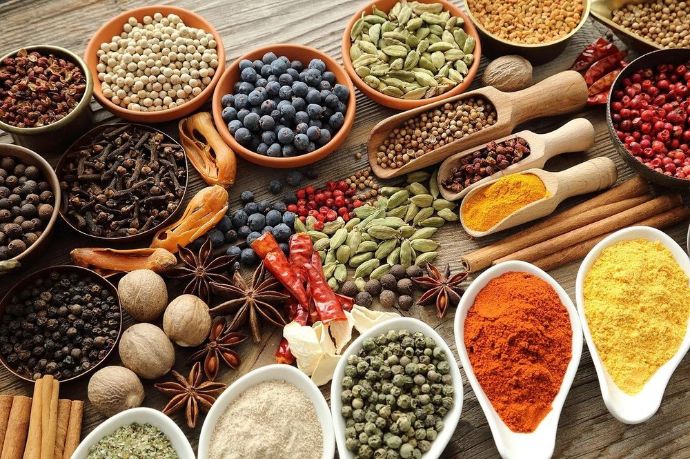Are you tempted by the street food covered in layers of spices and other condiments? If you like the taste of the spices then this article will let you know some unique and interesting facts about them.
Spices are in general the dried and ground herbs that are used to season the food so that its taste is accentuated.
However, the benefits of spices aren’t just limited to enhancing the taste. It has several health benefits that keep us immune and helps in the digestion of the food we eat.
Some spices have medicinal properties which have endorsed the usage of spices. Others also have antimicrobial properties and are hence used as food preservatives.
Keep on reading this article to know the interesting facts about this culinary marvel. Here are some of the facts about spices:
- The English word spice is derived from the French word espice that later was termed as epice. And the word epice was actually inspired from the Latin syllable spec which refers to “appearance, kind”. Early Romans promoted the use of spices in medicine, food and skin care products as well. However, today the South Asian country India is well known in the world for all producing and using varied kind of spices.
- Spice was one of the main ingredients which used to be traded in the early centuries. The trend o spice trade began from Indian subcontinent in the early 2000 B.C. Some spices like Cinamon, black pepper and other herbs were majorly traded. For seven centuries, from eight to fifteenth, Venice used to have monopoly over the trading of spice with middle east and Italian countries. Eventually, coming to the present day, India contributes to the 75% of total spice production in the world.
- Black pepper is one of the most used spices around the world. In fact, the United States is the biggest consumer of black pepper in the world, importing almost 18% of the world’s pepper in 2009. It is also called King of Spices and is often shared on with salt.
- One of the most expensive spices of the world is Saffron and it is majorly produced in a place called Kashmir in India. A single saffron flower has three stigmas and each of the flowers is handpicked individually to pick just three stigmas. That’s why even a few grams of saffron costs too much.
- Turmeric has anti- inflammatory properties and it detoxifies liver as well as help in maintaining blood sugar levels. It has an active substance called curcumin which gives anti-inflammatory property to the spice.
- Similarly, fenugreek is another widely used spices, most often in South-Asian households. Fenugreek is rich in fiber, proteins, essential amino acid and some major vitamins. It is also used as a complementary feed for horses s well as veterinary medicine. However, it can pose some allergic side effects in body if correct dosage isn’t used.
- Cardamom is also a popular spice that has a varied range of usage because of its intense aroma and strong flavor. Among the two major types of the spice, green one has on the sweeter side while the black one is smoky and distinct flavor which suits for curries. The green cardamom is the third most expensive spice in the world after saffron and vanilla.
- Another beautiful aromatic wood that accentuates the flavor of different cuisine is Cinnamon is used to cook dishes ranging from main course to the dessert. It is used as a taste enhancer in tea, curries, and bakeries. One interesting fact about this woody spice is that it doesn’t have its own sweetness however, it amplifies the sweetness of the dish in which it is used. A compound called caryophyllene gives the flavor to cinnamon.
- Similarly, another most loved spice in the South Asian Cuisine is cumin seeds. It is in fact the second most popular spice in the world with black pepper. There was myth in middle age that cumin prevented lovers and the chickens from running away. In fact, people used to gift and carry cumin during wedding with a belief it would lead to happiness.
- Asafoetida is a miraculous spice that can sharply raise the taste and flavor of the food items. It has a very high concentration of sulfur thus; it has a strong and pungent odor. This spice is often called as devil’s dung because of it unpleasant and stinky smell. Asafoetida is also considered a medicine for digestion problems and other stomach issues lie intestinal worms, bloating and irritable bowel symptoms.
- Coriander is one of the oldest herbs that is still used widely as a spice to enhance the flavor of any cuisine. Both the leaves and the seeds of this herb is used in cooking. The word coriander actually comes from a Greek word called koris which means a stink bug. The leaves of young coriander herb are used for dressing purpose whereas the seed that comes out of the flower is used only after ripening and drying properly.
- Nutmeg is another unique spice which people rarely know about. It contains essential oils which has varied medicinal properties and usage. We find nutmeg in market in the form of powder or a whole fruit. If consumed in higher amount, nutmeg can have hallucinogenic effect. According to some researchers, consumption of nutmeg in ample amount can help in promoting recovery of tissues in brain after stroke. It can also slow down cognitive declination in people who have been diagnosed with Alzheimer’s.
All these different spies can have a wide range of usage and benefits; however, it is maybe detrimental to overuse or misuses them. Certain people can be allergic to the smell, texture, or flavor of some spices which can lead to a hyperallergic reactions.
Hence, the ample use of these beneficiary herbs is best to get the right advantage from it.

